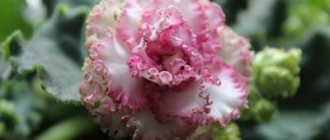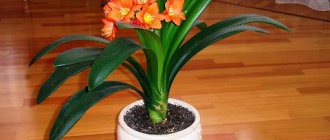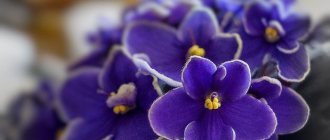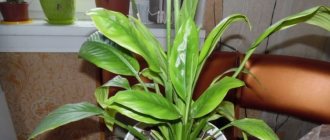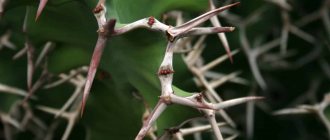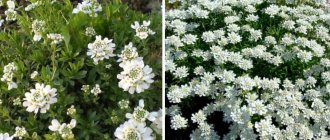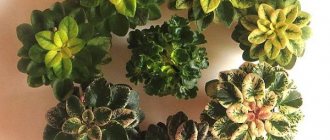A plant with magnificent leaves, as if painted by an artist, decorates and enlivens homes, offices and shop windows. Maranta is a flower that in the West is called “praying” or “10 commandments.” The leaves can fall and rise with the sun, like the hands of a praying person. One type of arrowroot has 10 large spots on the leaf blades. What a reminder of the same number of Old Testament commandments! The flower itself is unknown to human passions; for complete happiness it needs the right place in the room and good care.
Features of the plant
The genus and family were named after the medieval physician and botanist Bartolomeo Maranta. Representatives of the botanical genus Maranta are evergreen perennials from the tropics and subtropics of America. The climate in its natural habitat is humid, warm, with bright light, muffled by the crowns of trees and shrubs. Arrowroot dreams of such conditions at home.
Features of this group of plants.
- Height from 20 to 60 cm.
- The roots are well developed, sometimes forming tuberous thickenings.
- The stems are short, recumbent, the shoots are creeping and erect.
- The leaves are oval-rounded or lanceolate, large, 6–10 wide, up to 16 cm long.
- The main color of the leaf blades is soft green, dark green, almost white or silver; the upper and lower sides are colored differently, which is clearly visible in the photo of arrowroot.
- Along the main vein, 5–7 pairs of velvety, dark green, almost black, beige or brown spots stand out sharply.
- Additional leaf patterns are created by bright veins, dots and lines.
Arrowroot can bloom from April to May. The corollas are small, inconspicuous, white or lilac.
Arrowroots usually bloom in a room at a more mature age. Even less often in our latitudes do fruits develop—single-seeded capsules.
The Maranta kerchoveana variety is known as the "10 Commandments" plant. On large leaves, 10 dark spots are clearly visible. The beautiful name "prayer plant" reflects the fact that arrowroot responds to changes in light with the movements of its leaf blades in order to survive in the understory of an evergreen forest.
This process is called nyctinasty. During the day, the leaves are located horizontally, at night vertically, at a slight angle, resembling hands folded for prayer. This is how the popular name arose - “prayer flower”.
Watch a video with accelerated footage of arrowroot “praying” (80 seconds).
Echoes of such fame went to some other plants - Calathea and Stromanthe. Since they belong to the Marantaceae family, their leaves are also capable of lifting in response to daily changes.
If you choose an arrowroot plant for your green collection, you will have the opportunity to observe the evening movements of the leaves. The plant has a compact size, attractive leaves, and does not require care. However, with a deficiency or excess of light, the pattern will be less pronounced.
FAQ
Calathea is an unusual plant, unusual for our middle latitudes. It is not surprising that in connection with it, flower growers have questions, many of which are not related to the nuances of care. Let's look at the most frequently asked questions.
Why is Calathea called the “prayer plant”?
Some species of the arrowroot family, including a number of calathas, have one surprising feature. At the end of each petiole, next to the leaf blade, there is a thickening. It lifts the leaf and turns it towards the light so that it can capture as much of the sun's rays as possible as they filter through the dense canopy of the rainforest. As a result, the leaves, located horizontally on the soil in the morning, rise vertically in the evening, resembling palms folded in prayer. For this feature, Calathea was nicknamed the “praying flower.”
Where did the name of the plant come from?
The name of the genus comes from the word “Kalathos”, which is translated from Greek as “basket”. The origin of the name is not accidental. The thick central vein that divides the calathea leaf in half is very strong and flexible. According to these indicators, it is comparable to willow twigs. Since ancient times, this feature has been used by people living in the tropics to make light and durable baskets. They are still part of folk crafts and, like other wickerwork made from Calathea leaves, such as hats and bags, are popular among tourists coming to South America. They buy them as exotic souvenirs.
Is calathea dangerous or not for people and cats?
Despite the fact that the sap found in the cells of plants of the Marantaceae family is considered poisonous, this tropical beauty, judging by the reviews about it, is absolutely harmless and does not pose a danger to people, cats and other pets. In tropical countries, vegetables, fruits, herbs and freshly caught fish are wrapped in its large leaves instead of paper. But calathea itself is inedible, and chewing its leaves is not recommended.
All articles about calatheas on the site can be found by following this link: CALATHEAS
The brighter and more unusual the indoor flower, the more signs and superstitions it is endowed with and the more capricious its character. And this is the similarity between plants and people. As a true recognized beauty, Calathea requires attention to itself, but at the same time it is sensitive to care and gives everyone who contemplates it a lot of positive emotions.
Types and varieties of arrowroot
Approximately 40 species of the genus Maranta are found in nature. However, mainly the plant Maranta leuconeura and its varieties (varietas) have become widespread in indoor culture. Several more species are rare and collectible. Each species, variety and cultivar has its own leaf pattern.
Reed arrowroot (M. arundinacea) is a food and industrial plant. Thickened rhizomes with tubers are used to produce starch, which has dietary properties.
White-veined
Maranta leuconeura is a charming and unpretentious indoor plant that overwinters well on windows at normal temperatures. Creeping shoots 20–30 cm high develop from a storage tuberous rhizome. The leaves are wide and long (up to 8 cm wide and 12–15 cm long), oval-shaped, brightly colored.
The surface of the leaf blade has a clear dark green and light green pattern between light veins. Thanks to them, the Russian specific epithet appeared - “white-lobed”, “white-lobed” (“white-lobed”).
Varieties and cultivars of M. leuconeura differ in the tone of their veins and spots. The former are most often silvery-white, but can be pink or red. The spots are light green, silver-green, brownish. The underside of the leaves is bluish-green, and in some cultivars it is purple.
Tricolor (tricolor)
Arrowroot tricolor or M. fascinator tricolor is a variety of white-veined arrowroot (M. leuconeura var. fascinator tricolor). The leaves of this popular indoor plant are striking in their bright colors. All color options are clearly visible. The middle part of the plate along the main vein is dark green, the edges are light.
Another option: the central part of the leaf is decorated with a light green zigzag and dark green spots on a light green background. The middle vein and the veins extending from it are crimson or bright red. This is how the Russian name of the variety appeared - M. red-veined. The lower part of the sheet is painted wine color.
Arrowroot massage
Massangiana most justifies the name white-veined. The veins are silvery on a dark green background.
For the variety M. leuconeura var. massangeana is characterized by shoots only 15–18 cm high and small olive-green leaves. There are brown or almost black spots in the center. The underside of the leaves is purple-red. The variety requires more attention and more careful care than the original type.
Maranta Kerkhoven
M. leuconeura var. kerchoviana is a larger variety of arrowroot than M. massanja. The leaves of this plant are emerald green, decorated with 4-5 pairs of large olive-brown spots or “eyes” located to the left and right of the central vein.
The lower part of the leaf blade is blue-green with red spots. The veins are not highlighted in color. At night the leaves turn vertically.
M. leuconeura var. erythroneura is a variety with red veins on olive green leaves. White and dark green spots are also present in the color.
M. leuconera 'Amabilis Mint' is a rare variety with small leaves the color of fresh mint, with darker highlights. The underside is purple.
Two-color (bicolor)
The indoor flower of arrowroot cristata or bicolor (M. cristata / M. bicolor) is much less common than M. white-veined and its varieties. Distinctive features of the species are upright growing shoots 20 cm high and the absence of tubers. Leaves with wavy edges are located on reddish petioles; they are bluish-green above and purple below.
Velvety dark green, brown or brown oval spots are clearly visible along the leaf blade. So far, this species is known mainly to breeders and professional florists.
Reed
Reed arrowroot (M. arundinacea) is distributed from Mexico to tropical South America. Various forms of this species are used in indoor floriculture, for example, the variegated M. arundinacea “Variegata”. The squat shrub reaches a height of 50–100 cm. The root is thick and tuberous. The leaves are oval-shaped with a pointed tip, rather long (13–20 cm). White and green stripes of different shapes and thicknesses run from the central vein to the edge of the plate.
Cane arrowroot contains up to 23% starch. The English trade name for the food product made from the roots of the plant is Arrow Root. Arrowroot starch is easier to digest in the body than wheat flour or cornstarch. Arrowroot is used to make smooth sauces, puddings, glazes and jellies.
Growing calathea indoors
Considering the capricious nature of arrowroot, we can recommend several species of beautifully flowering and decorative foliage representatives of the Calathea genus for growing indoors. Easier than others to adapt to life in indoor conditions are Calathea Bachema, decorated, Makoya, striped, Veitcha. If you are patient, then Calathea saffron and Calathea Varshevich will bloom in the room, distinguished by bright bracts of different shades of white, pink, orange, mistaken for a flower.
Calathea Makoya. © Maja Dumat
Calathea Makoya
The tropical rainforests of Brazil are the natural habitat of Calathea Macoya. She does not like spraying and therefore will grow and develop better in greenhouses, where the natural air humidity is always quite high.
Under artificial lighting, this species is in no hurry to lose leaf variegation. It is distinguished by the amazing beauty of large (up to 20x10 cm) leaf blades on straight petioles up to 14 cm long. On an oval leaf blade of light green color with a dark green edge, with a thin brush of a natural artist, a second dark green, imparipinnate leaf is “painted” on top. The reverse side repeats the design, but in burgundy colors.
The unusual bright color of the plant is especially evident in the evenings, when the leaf blades rise up and curl, revealing the unique color of the underside of the leaf.
Calathea warscewiczii. © Blechdose
Kalathea Varshevich
A large species that forms the habit of a bush with dense rosettes of leaves from 0.3 to 1.0 m. The leaf blades are elongated-oval, slightly wavy. The leaf surface is dark green velvety with a light green herringbone pattern. The underside of the leaf blades is dark purple in color.
In addition to the leaves, the inflorescences of Calathea Varshevich are attractive in the form of spikelets on short burgundy peduncles. The few-flowered spikelet bears large light bracts (white, light cream) surrounding cream or pink flowers. Flowering begins in late spring and lasts up to 3 weeks.
Calathea saffron. © martinsvaxte
Calathea saffron (crocata)
This beauty from the banks of the Amazon attracts the eye with the special decorativeness of its “false” flowers, collected in short corymbose inflorescences on high peduncles.
The true flowers are small and inconspicuous, reddish or pink, hidden in large bracts of bright orange or saffron hues, mistaken for the flower. Against the background of 20-30 cm of velvety dark green leaves, bright orange inflorescences give the plant a special charm. However, for the onset of flowering, Calathea saffron needs a shortened daylight hours (8-10 hours a day), so flowering occurs in early spring or in the autumn-winter period.
How to care for arrowroot at home
All varieties of the Maranta plant require virtually the same care, regardless of leaf pattern. At first, caring for arrowroot makes it difficult to find a suitable place in a room or office. A tropical plant needs to create conditions similar to those that exist in its natural habitat. Replanting arrowroot does not cause any difficulties, including in hydroponic culture.
Lighting
Maranthus indoor plants, unlike many other variegated indoor flowers, do not require too bright lighting.
Velvety, variegated leaves do not tolerate direct sunlight. The flower can be hung nearby or placed near the window. In summer, never leave the plant on a sunny windowsill without covering at midday.
The place for arrowroot should not be too lit and at the same time not dark, although arrowroot is tolerant of partial shade. If the plant lifts its leaves vertically during lunch, it means there is too much light.
You can shade with thin white paper, placing it between the flower and the glass so that direct sunlight does not fall on the pot and leaves. Full shade should also be avoided because the color intensity is reduced.
Temperature
Maranta is best suited for greenhouse-like temperatures and humidity. Cool and too dry air causes leaf loss. It is important not to place the indoor flower in direct sunlight, near a radiator or balcony door.
Arrowroot tolerates temperatures from 16 to 27°C. degrees Celsius. If it is constantly cool (15–16°C), the leaves may fall off. The plant requires warmth most of the year.
During the day from spring to autumn, you need a temperature of about 22–25°C, at night - no lower than 18–19°. In winter, the dormant period of arrowroot is not pronounced. During the day, 18–20°C is required, at night not lower than 16°C.
Watering and spraying
To properly care for arrowroot at home, remember a few rules:
- Water the flower more often during the growing season than during the wintering period.
- From March to October the plant requires more heat and water.
- The signal for the next watering in the warm season is when the top layer of the substrate dries to a depth of 1 cm.
- During the rest period from October to February, water moderately, allowing the substrate to dry halfway.
- Use settled or filtered water with low hardness.
Humidity should be high all year round (at least 60%). In hot weather, place the pot with the flower in a bowl or high tray on pebbles, pour in enough water so that its level is below the bottom of the container with the flower. Or place a wide container of water next to your indoor plants.
Spray the leaves with warm, soft water. Unfortunately, this method only increases the humidity for a short time. In addition, it is not recommended to spray plants with velvety leaves.
Top dressing
During the period of active growth, add fertilizers to the water for irrigation. For arrowroot, ½ dose recommended by manufacturers of products for feeding indoor plants is enough. If you choose a product from the “Mr. Color” series, then the “Ficus” release form for decorative deciduous crops is suitable. The NPK ratio is 9:3:4, there are trace elements, amino acids, and vitamins.
In the warm season, add fertilizer to the water for irrigation once every 2 weeks. From September to March it is enough to feed once.
Trimming
Remove dried leaves with scissors all year round. Arrowroot pruning is carried out in early spring, but it is not needed every year. Shorten stems that are too long by 2/3 of their length. Use cut shoots for cutting cuttings and propagating arrowroot.
Transfer
A young arrowroot needs replanting every year, an older specimen needs replanting every 2 years, but only when the roots completely entwine the ground in the pot.
The root system of indoor flowers is shallow, so use low, wide containers. Prepare the soil for arrowroot from equal parts of leaf soil, humus, peat and sand. Drainage at the bottom should occupy 25% of the volume of the pot.
Commercially available substrates are suitable as soil - universal, for ornamental foliage plants or for rhododendrons.
Calathea propagation
Breeding calathas is a painstaking task, and those who manage to preserve this gorgeous flower strive to obtain new specimens from the mother plant. There are several ways:
- Leaf propagation. This method does not promise a 100% guarantee due to the capricious nature of the culture. It is necessary to carefully cut off a large and healthy leaf, and then stick it into the prepared soil until roots appear. To speed up this process, the container with soil is covered with glass on top. Under such conditions, the humidity of the substrate is always uniform due to the appearance of condensation.
- The principle of propagation by cuttings is similar to the previous one. In this case, the daughter process is disconnected. If it has considerable dimensions, then instead of glass you can cover it with a plastic bottle with the neck cut off.
- When growing a flower from a seed, it is necessary to take responsibility not only for soil moisture, but also for temperature. For best germination it should be about 25 degrees. The soil mixture is made up of two parts leaf soil and one part sand.
To be on the safe side, it is recommended to plant as many seeds as possible, because growing calathea in this way does not guarantee one hundred percent results.
This is interesting : many plant lovers still don’t know whether calathea blooms. If you haven’t been able to admire the buds for a long time, then most likely it’s this species. Among the flowering Kalatas one can highlight Shafrannaya, Varshevich and Makoya.
How to propagate arrowroot
An adult, well-leafed bush can be divided into 2 or more parts, each planted in a separate pot. The second method of propagating arrowroot at home - cuttings - is also simple.
Dividing the bush
To propagate arrowroot, divide the mother plant. The easiest way to do this is in the spring when replanting. Remove the root ball from the pot, lightly shake off the soil, and divide the bush into the required number of parts. Plant each new plant with a sufficient number of roots, stems and leaves in a separate container. Use the same soil for arrowroot as when transplanting.
Keep young plants in warm, humid conditions, otherwise they will not take root. After planting the divided bushes, cover the soil surface with sphagnum and keep it moist.
Propagation by cuttings
Cut off the tip of the shoot (7-10 cm) directly below the leaf node. Remove the lower leaves and soak the cut end in a solution of heteroauxin (a hormone and root growth stimulator). Place the cutting in a glass or jar of water and replace it with fresh water every 2 days. Through the glass you will be able to see the roots growing. You can root cuttings in a mixture of equal parts of peat and sand.
Plant a young plant with roots 2–3 cm long in a pot of soil. The node (pictured) should be in the soil. Cover the top of the cutting with a tall plastic glass or plastic bag. From time to time, remove the cover, water and spray the plant.
Propagation of arrowroot by dividing the bush and cuttings usually does not cause difficulties even for inexperienced gardeners. The problem may be maintaining soil temperature at 25–30°C and high humidity. If the conditions are met, roots should appear in 5-6 weeks. After this, the young plant can be transplanted into a permanent pot.
Diseases
If at some stage a mistake is made, the calathea begins to hurt. This is often due to improper organization of space for cultural activity.
As a result, the disease can lead to sudden death if treatment is not started in time. To identify the disease, you should know the symptoms of its manifestation.
Change in petiole size
Lack of light often leads to elongation of the petioles, which subsequently become longer than the leaves themselves. To solve the problem, it is enough to adjust the lighting in the room.
The leaves are turning yellow
The reason why the leaves of the calathea plant turn yellow may be:
- unsuitable humidity and temperature in the room;
- presence of parasites;
- improper watering.
Brown spots
The appearance of dark pigmentation is a consequence of low soil moisture. Also, with a similar disease, the foliage may curl. To solve the problem, it is necessary to artificially increase humidity levels.
This can be achieved either by spraying the adjacent space without getting moisture on the bush, or by adding sphagnum moss to the tray of the pot, which retains liquid well.
Dry leaves
In this case, the loss of attractiveness is caused by exposure to direct rays of the sun. To prevent this from happening, it is recommended to shade the calatheas, especially if they are located on the windowsill. This can be done easily by simply placing other indoor plants nearby.
Pest protection
Caring for arrowroot at home is sometimes overshadowed by an invasion of insects - spider mites, scale insects, mealybugs. Affected plants become covered with cobwebs (mites) and sticky spots (scale insects).
First aid measures for pest infestation:
- removing damaged leaves;
- washing the plant with warm water;
- increasing air humidity in the room;
- frequent spraying with warm soft water.
If simple control methods do not help, then use chemicals. Acaricides are used against ticks - “Fufanon Nova”, “Aktellik”. Fitoverm and Aktara are effective against scale insects and mealybugs.
general description
The name “calathea” comes from the Greek word for basket. Modern inhabitants of the “concrete jungle” appreciate the eye-catching beauty in the leaves of the plant. Their unusual coloring and smooth, symmetrical patterns. In this case, concerns about creating tropical conditions in the apartment become a kind of payment.
Calathea is a perennial deciduous plant belonging to the Marantaceae family. Doesn't tolerate well:
- direct sunlight;
- dryness;
- drafts;
- temperature drop.
In indoor conditions it grows to a height of up to one meter, representing a lush bush of wide leaves.
On a note!
Numerous species of calathea have leaves of different shades with unique patterns of spots and stripes, round, oval or lanceolate in shape, with a smooth or velvety surface.
The back side often differs in color from the front side; its color always contains reddish shades. The leaves are large, from 20 to 40 cm long, on short stems. They are characterized by a thick central vein with lateral veins extending at right angles and parallel to each other. Thanks to this, as well as the thickening of the petioles at the base of the leaves, calatheas are able to turn them towards the sunlight, and after sunset, raise and fold them, like folding hands in prayer. This feature gave the plant its second name - “prayer flower”.
Calathea flowers, with the exception of a few species, are valued less than the variegated variety of foliage patterns. Flowering begins in the spring, and within a month, spike-shaped inflorescences of small and simple flowers appear - white, pink or yellow.


